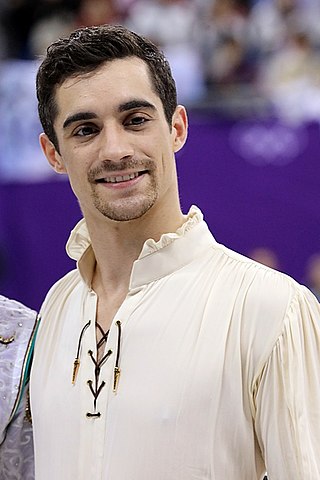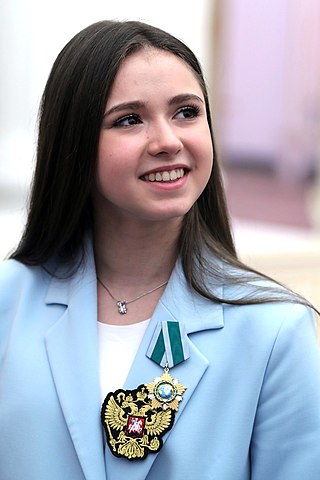Figure skating jumps are an element of three competitive figure skating disciplines: men's singles, women's singles, and pair skating – but not ice dancing. Jumping in figure skating is "relatively recent". They were originally individual compulsory figures, and sometimes special figures; many jumps were named after the skaters who invented them or from the figures from which they were developed. It was not until the early part of the 20th century, well after the establishment of organized skating competitions, when jumps with the potential of being completed with multiple revolutions were invented and when jumps were formally categorized. In the 1920s Austrian skaters began to perform the first double jumps in practice. Skaters experimented with jumps, and by the end of the period, the modern repertoire of jumps had been developed. Jumps did not have a major role in free skating programs during international competitions until the 1930s. During the post-war period and into the 1950s and early 1960s, triple jumps became more common for both male and female skaters, and a full repertoire of two-revolution jumps had been fully developed. In the 1980s men were expected to complete four or five difficult triple jumps, and women had to perform the easier triples. By the 1990s, after compulsory figures were removed from competitions, multi-revolution jumps became more important in figure skating.

Surya Varuna Claudine Bonaly is a French-born retired competitive figure skater. She is a three-time World silver medalist (1993–1995), a five-time European champion (1991–1995), the 1991 World Junior Champion, and a nine-time French national champion (1989–1997).

Midori Ito is a retired Japanese figure skater. She is the 1989 World champion and the 1992 Olympic silver medalist. She is the first woman to land a triple-triple jump combination and a triple Axel in competition. At the 1988 Calgary Olympics, she became the first woman to land seven triple jumps in an Olympic free skating competition. She is widely recognised as one of the best figure skaters of all time.
The toe loop jump is the simplest jump in the sport of figure skating. It was invented in the 1920s by American professional figure skater Bruce Mapes. The toe loop is accomplished with a forward approach on the inside edge of the blade; the skater then switches to a backward-facing position before their takeoff, which is accomplished from the skater's right back outside edge and left toepick. The jump is exited from the back outside edge of the same foot. It is often added to more difficult jumps during combinations and is the most common second jump performed in combinations. It is also the most commonly attempted jump.
The flip jump is a figure skating jump.

Timothy Richard Goebel is an American former competitive figure skater. He is the 2002 Olympic bronze medalist. He was the first person to land a quadruple salchow jump in competition and the first person to land three quadruple jumps in one program. He landed 76 career quadruple jumps before his retirement in 2006.
The loop jump is an edge jump in the sport of figure skating. The skater executes it by taking off from the back outside edge of the skating foot, turning one rotation in the air, and landing on the back outside edge of the same foot. It is often performed as the second jump in a combination.

Javier Fernández López is a Spanish former figure skater. He is the 2018 Olympic bronze medalist, a two-time World champion, a two-time World bronze medalist, a seven-time European champion (2013–2019), a two-time Grand Prix Final silver medalist, a three-time Rostelecom Cup champion (2014–2016), a two-time Grand Prix in France champion (2016–2017) and an eight-time Spanish national champion.

Dmitri Sergeyevich Aliev is a Russian figure skater. He is the 2020 European champion and the 2020 Russian national champion. On the junior level, he is the 2017 World Junior silver medalist, the 2016–17 Junior Grand Prix Final champion, a two-time medalist at the 2016 Youth Olympics, and a two-time Russian national junior champion.

Evgeni Vladimirovich Rukavicin is a Russian figure skating coach. He coaches ladies' and men's singles.

You Young is a South Korean figure skater. She is the 2020 Four Continents silver medalist, a four-time Grand Prix bronze medalist, a four-time Challenger series medalist, and a five-time South Korean national champion

Rika Kihira is a Japanese figure skater. She is a two-time Four Continents champion, the 2018 Grand Prix Final champion, a four-time Grand Prix series medalist, a two-time International Challenge Cup champion, and a two-time Japanese national champion. As of 25 March 2022, Kihira is the twelfth highest ranked women's singles skater in the world by the International Skating Union.

Alexandra "Sasha" Vyacheslavovna Trusova is a Russian figure skater. She is the 2022 Olympic silver medalist, the 2021 World bronze medalist, a two-time European bronze medalist, the 2019 Grand Prix Final bronze medalist, the 2019 Skate Canada champion, the 2019 Rostelecom Cup champion, the 2019 CS Ondrej Nepela Memorial champion, the 2021 U.S. Classic champion, and the 2021 Skate America champion. Domestically, she is the 2022 Russian national champion, the 2019 silver medalist, and the 2020 and 2021 bronze medalist. At the junior level, she is a two-time Junior World Champion, the 2018 Junior Grand Prix Final champion, the 2019 Junior Grand Prix Final silver medalist, a four-time champion on the Junior Grand Prix series, and a two-time Russian Junior national champion.

Stephen Gogolev is a Canadian figure skater. He is the 2023 CS Autumn Classic bronze medalist and the 2019 Canadian national silver medalist.

Alysa Liu is a retired American competitive figure skater. She is the 2022 World bronze medalist, the 2021 CS Nebelhorn Trophy champion, the 2021 CS Lombardia Trophy champion, and a two-time U.S. national champion. At age 16, she competed in the 2022 Winter Olympics, placing seventh.

Anna Stanislavovna Shcherbakova is a Russian figure skater. She is the reigning Olympic champion (2022), a World champion (2021), and a three-time Russian national champion (2019–2021). She was the first woman figure skater to land a quad Lutz in senior competition and the first woman to land two quad Lutz jumps in a single program. She was also the first woman figure skater to land a quad flip in combination with a triple jump, as well as the first to land two quad flip jumps in a single program. She was the first Olympic champion in women’s single skating with quad jumps. The quad Lutz and quad flip are among the three most difficult jumps in figure skating, only behind the quad axel. Additionally, she never finished below second place in her senior career.

Kamila Valeryevna Valieva is a Russian figure skater. She is the 2022 European champion, 2021 Rostelecom Cup champion, 2021 Skate Canada International champion, and 2021 and 2023 Russian National silver medalist. She is also a provisional 2022 Olympic champion in the team event pending the conclusion of a WADA investigation. During the 2022 Winter Olympics, a sample that Valieva had submitted for a drug test in December tested positive for trimetazidine. Investigations and legal battles are still on going, and on June 22, 2023, the Court of Arbitration for Sport (CAS) said that the hearing in Valieva's doping case involving the Russian Anti-Doping Agency (RUSADA), International Skating Union (ISU) and World Anti-Doping Agency (WADA) will take place Sept. 26–29, 2023. On September 28 CAS "ordered the production of further documentation" and announced that her hearing had been adjourned until November 9-10. It appeared that one of the parties in the case requested a file that had not previously been a part of the proceedings. On 10 November, CAS announced that a final decision was expected by the end of January, 2024.

Ilia Malinin is an American figure skater. He is the 2023 World bronze medalist, the 2022-23 Grand Prix Final bronze medalist, a four-time Grand Prix medalist, a three-time ISU Challenger Series medalist, the 2023 U.S. national champion, and the 2022 U.S. national silver medalist. At the junior level, Malinin is the 2022 World Junior champion, and a two-time Junior Grand Prix medalist. He holds the current world junior record for the men's short program, free skate, and combined score.

Sofia Dmitrievna Akateva is a Russian figure skater. She is the 2023 Russian champion. At the junior level, she is the 2021 JGP Russia champion, the 2021 JGP Poland champion, a two-time Russian junior national champion, and currently holds the junior women's world records for the highest total and free skate scores.

Sofia Vladimirovna Samodelkina is a Russian figure skater. She is 2021 JGP Slovenia silver medalist, 2021 JGP Russia bronze medalist, and 2021 Denis Ten Memorial Challenge champion.


















